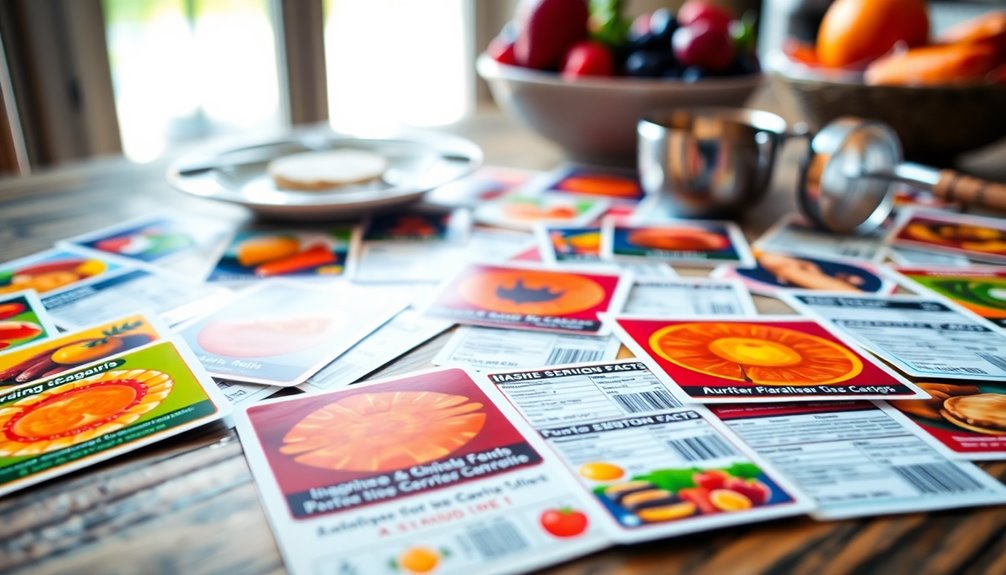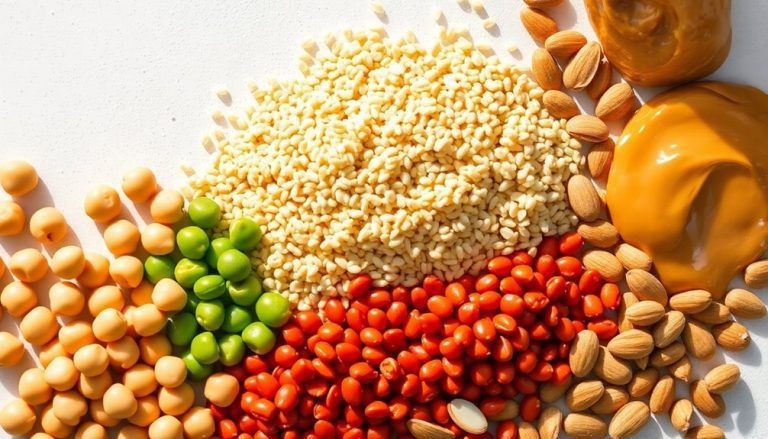Serving sizes on food labels show you the standard amount for a single portion, making it easier to track your calorie and nutrient intake. This helps you avoid unintentional overeating, as misunderstanding serving sizes can lead to consuming more than intended. These sizes are determined by nutritional needs, eating habits, and even cultural context. It's important to note that serving sizes vary between food types and aren't tailored to individual dietary requirements. Familiarity with serving sizes is key to maintaining a healthy diet. Keep going to discover tips that can help you read food labels more effectively!
Key Takeaways
- Serving sizes indicate the standard amount for one portion as defined on food labels.
- They help consumers understand calorie and nutrient intake for better dietary choices.
- Serving sizes vary by food type and are influenced by cultural and regulatory factors.
- Misunderstanding serving sizes can lead to overeating and unintentional weight gain.
- Accurate serving sizes are essential for effective meal planning and maintaining a balanced diet.
Understanding Serving Sizes

Understanding serving sizes is crucial for making informed food choices. When you look at a food label, the serving size tells you how much of the food is considered a single portion. This information helps you gauge how many calories, fats, sugars, and other nutrients you're consuming. It's easy to underestimate how much you're eating if you don't pay attention to these sizes.
For instance, a bag of chips might list a serving size as 1 ounce, but that could be just a handful. If you eat the whole bag, you're consuming several servings, which can lead to exceeding your daily caloric intake without realizing it. Familiarizing yourself with standard serving sizes can help you make smarter decisions about what and how much to eat. Additionally, using tools like organic mulching materials can help improve your overall health by contributing to a balanced diet.
You might also notice that serving sizes vary between products, making it essential to compare similar items. By understanding what a serving looks like, you can better manage your portion control. Additionally, knowing the importance of appropriate serving sizes can guide you towards healthier eating habits.
This awareness helps you enjoy your favorite foods while still maintaining a balanced diet. Remember, it's not just about what you eat but also how much, so take the time to learn and apply serving sizes in your daily meals.
Importance of Accurate Measurements
Accurate measurements play a vital role in managing your diet and health. When you know the right serving sizes, you can better control your calorie intake and make informed food choices. Misjudging portions can lead to overeating, which may contribute to weight gain and various health issues.
Understanding serving sizes helps you track nutrients effectively. If you're aiming for specific dietary goals, like increasing protein or reducing sugar, accurate measurements ensure you hit those targets. It's easy to underestimate how much you're actually consuming, especially with foods that are calorie-dense. Just as using the right plant food can optimize growth, precision in measuring food portions can enhance your nutritional intake.
Moreover, using accurate measurements can enhance your cooking skills. When you measure ingredients precisely, you'll achieve consistent results in recipes, making your meals tastier and more satisfying. You'll also be less likely to waste food by over-preparing.
In a world filled with conflicting dietary advice, sticking to accurate measurements can simplify your approach to healthy eating. By keeping an eye on serving sizes, you empower yourself to make better choices, leading to improved overall wellness. Additionally, using fertilizer tablets in your garden can be likened to measuring servings; just as precise measurements promote health, the right nutrients promote plant growth.
How Serving Sizes Are Determined

Determining serving sizes involves a blend of scientific research and practical application. Food manufacturers and regulatory agencies work together to establish these sizes based on various factors like nutritional content, consumption patterns, and portion sizes people typically eat.
Here's a quick overview of how serving sizes are determined:
| Factor | Description | Impact on Serving Size |
|---|---|---|
| Nutritional Needs | Evaluates the recommended daily values for nutrients | Ensures balanced intake |
| Consumer Surveys | Analyzes how much people usually eat | Reflects real-life habits |
| Food Type | Considers the type of food (e.g., solid vs. liquid) | Influences portion perception |
| Regulatory Standards | Follows guidelines set by organizations like the FDA | Maintains consistency |
| Cultural Context | Takes into account cultural eating habits | Affects portion expectations |
Additionally, serving sizes are often influenced by cultural eating habits, which can vary significantly across different societies.
Common Misconceptions About Serving Sizes
Many people have misconceptions about what constitutes an appropriate serving size, leading to confusion and unhealthy eating habits. One common misunderstanding is that serving sizes are the same as portion sizes. While a serving size is a standardized measurement on food labels, a portion is the amount you choose to eat. This difference can cause you to consume more calories than you realize.
Another misconception is that serving sizes are one-size-fits-all. In reality, they can vary widely based on the food type and individual dietary needs. For instance, a serving size of nuts might be just a small handful, while a serving of pasta could be much more substantial.
Many assume that if a food label lists a serving size, it's a healthy amount to consume. However, labels mightn't consider your personal nutritional needs or goals. You might think that snacks like chips are okay to eat in the entire bag since they're marketed as "healthy," but their serving sizes might be misleading.
Stay aware of these misconceptions to make better choices for your diet. Understanding serving sizes is a crucial step in managing your nutrition effectively.
Tips for Reading Food Labels

How can you make sense of the information on food labels? Start by checking the serving size. This tells you the amount of food that the nutritional information is based on. If you eat more than the serving size, you'll need to adjust the calories and nutrients accordingly.
Next, look at the calories. This number helps you gauge how your food fits into your daily calorie goals. Pay attention to the percentage of Daily Value (%DV) for key nutrients like fiber, sugar, and vitamins. A %DV of 5% or less is low, while 20% or more is high.
Don't forget to read the ingredient list. Ingredients are listed in descending order by weight, so the first few are the most significant. If you see unfamiliar ingredients, it might be worth researching what they are.
Lastly, watch for claims like "low-fat" or "sugar-free." These can be misleading, so always check the actual nutritional content. By focusing on these aspects, you'll be better equipped to make informed choices about the foods you consume.
Frequently Asked Questions
Can Serving Sizes Vary Between Different Brands of the Same Food?
Yes, serving sizes can definitely vary between different brands of the same food. Each brand may have its own guidelines or marketing strategies, so you should always check the label to understand what you're consuming.
How Do Serving Sizes Affect Portion Control and Weight Management?
Isn't it ironic that understanding serving sizes can actually help you eat less? By knowing proper portions, you can control your intake, making weight management easier while still enjoying your favorite foods without guilt.
Are Serving Sizes the Same for Children and Adults?
Serving sizes differ between children and adults due to varying nutritional needs. When you're planning meals, consider age and activity level, ensuring children receive appropriate portions to support their growth and health while preventing overeating.
What Happens if I Eat More Than the Suggested Serving Size?
If you eat more than the suggested serving size, you might consume excess calories and nutrients, which can lead to weight gain or digestive discomfort. It's important to listen to your body and practice moderation.
Do Serving Sizes Consider Dietary Needs or Health Conditions?
Serving sizes don't always consider individual dietary needs or health conditions. They're general guidelines. You should adjust portions based on your unique health requirements, activity levels, and specific nutritional goals for better overall well-being.
Conclusion
In the world of nutrition, serving sizes are your compass, guiding you through the maze of food choices. By understanding and accurately measuring these portions, you can navigate towards healthier eating habits. Don't let misconceptions steer you off course; instead, take control by reading food labels carefully. Remember, each meal is a chance to fuel your body wisely, so embrace the journey and make informed decisions that nourish both your body and soul.




